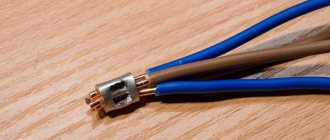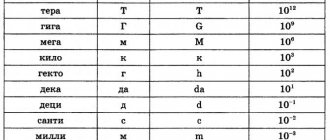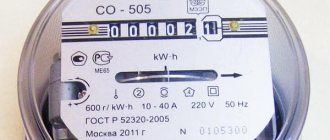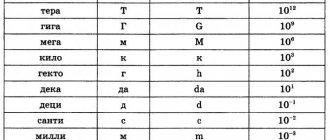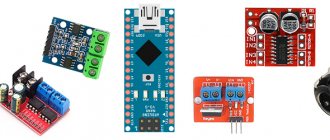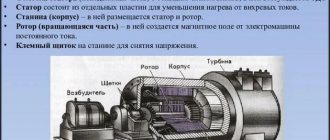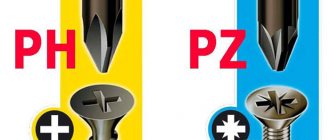Many people still believe that a screwdriver blade can only be of two types:
- splined - Ps
Popularly referred to as “minus” - flat.
The very concept of slot (schlitz) is translated from German as a groove or slot.
- cruciform
Moreover, as some believe, they differ from each other only in size (width and thickness of the tip) or diameter.
In fact, the shape of the cross-shaped profile also plays a significant role.
Moreover, the “cross” itself appeared much later than the slot. Due to the massive introduction of screwdrivers, using a straight slot with these devices has become not entirely convenient.
Therefore, we gradually switched to a cruciform shape. It centers better and is much easier to work with.
Classification of bits by material and coating
Their strength characteristics and wear resistance depend on the properties of the material from which the hardware is made, as well as on the coating.
The following alloys are considered the best for the manufacture of screwdriver attachments: chromium-vanadium (indicated by the symbols Cr-V);
- chromium-molybdenum (Cr-Mb);
- tungsten-molybdenum.
Hardware is also made from other metals, for example, from high-speed steel (from R7 to R12). But such cheaper alloys are inferior in their performance indicators (strength, wear resistance) to the considered options.
The screwdriver attachment for self-tapping screws, bolts and other types of fasteners can be coated with the following materials:
- nickel;
- titanium;
- tungsten carbide;
- diamond coating.
The applied coating increases the resistance of working tips to corrosive processes, increases their wear resistance, as well as strength characteristics. Titanium coating emphasizes the quality of the product. It has a yellow tint.
Features of flat and hex screwdrivers
Types such as hexagonal and flat tools are the most common. They are used for screws and self-tapping screws, for which there are no special requirements. So, the characteristics of a flat screwdriver are as follows:
- the tool fits a flat slot type;
- tightens screws and screws;
- The marking of such a product is marked by the width of the tip:
- The width of the product ranges from 1 to 10 mm depending on the model.
Flat-head screwdrivers are one of the oldest that began to be used for household needs and are still widely used.
The description of the hexagonal fixtures is as follows:
- Hex screwdrivers or inbuses are designed for fasteners with a hex slot.
- The most common type is an L-shaped bent rod with different hexagonal cross-section sizes.
- High torque, significantly exceeding the torque of a Phillips screwdriver.
- Areas of application: repairing electrical equipment and unscrewing fasteners in areas that are energized.
- Hex screwdrivers are labeled HEX, similar to the less popular square-type screwdrivers.
If the tool tips have a six-pointed star cross-section, then they are marked as Torx. Fasteners with such a slot are used for repairing mobile phones and other equipment. Such devices are used exclusively in service centers for repairing equipment and telephones.
Tip (sting)
The shape of the screwdriver tip should match the shape of the slot - the groove on the head of the screw or screw. Previously, the most common was a straight slot, but now fasteners with it are increasingly difficult to find, which is why not many straight screwdrivers are produced.
Now the most common is the Phillips slot (also called Phillips). There is also an improved version called Pozidriv. Such slots allow you to achieve greater torque, and the screwdriver tip does not fall out of them as easily as from a straight slot.
There are also hex splines and Torx splines (six-pointed star). They are designed for even greater loads.
Other types of slots can be classified as rare, and we advise you to buy screwdrivers with the appropriate tip shape only if necessary.
In addition to the shape of the tip, you need to pay attention to its size. Ideally, a specific tip size should be used for a specific slot size. Many people ignore this instruction and consider, say, a Phillips screwdriver to be universal, suitable for any Phillips slot. If you choose the wrong tip size and shape, you can break the tool or cut off the slot.
How to choose screwdriver size:
- Flat-head screwdrivers are marked with the Latin letters SL, followed by the width of the slot in millimeters. The width of a flat-head screwdriver can be from 2 to 18 mm; as its width increases, the thickness of the tip also increases. For most everyday tasks, the average user can get by with three flat-head screwdrivers of different sizes, say SL3, SL5 and SL8.
- Phillips screwdrivers are marked with PH symbols with a serial number (000; 00; 0; 1; 2; 3; 4). The most popular screwdrivers are PH2 size; they are suitable for most self-tapping screws and self-tapping screws used in everyday life.
The tip of the screwdriver must not only have the appropriate shape and size, it must be strong, hard, not brittle, and securely fixed in the slot. Achieving strength characteristics is facilitated by high-quality rod material and proper heat treatment.
In order for the tip to be securely fixed in the slot, it must be rough. The tips of high-quality screwdrivers are coated with a special coating with a high coefficient of friction, or notches are applied to its edges.
Requirements for the quality of Phillips screwdrivers
on product quality
Japanese or European products will be much higher quality than Chinese ones. But if you give preference to domestic products, then make sure that they have the GOST or RS markings, which indicate their high quality.
Now let's move on to other quality indicators
For example, pay attention to the strength of the product's core. According to standards, the strength level of the screwdriver shaft must be from 47 to 52 units on the Rockwell scale, which must be marked on the tool itself
If the indicator is below 47, then there is a high probability that the product will bend, and if it is above 52 units, then it may crack. It is also desirable that the rod be made from a chrome vanadium alloy; such a rod is marked on the tool as Cr-V.
Of course, unscrupulous manufacturers can put deliberately false labels, so it is better to purchase products from well-known brands.
The ease of use of the tool also depends on the quality of the handle. It is better to choose products with magnetic coating on the tip; a rubber handle would also be an excellent choice.
Please note that models with rubber handles should not be used in areas in contact with chemicals. Try the product by touch, it should not strain your hand or slip out
Screwdrivers are available for sale at different prices.
If you need high-quality products for occasional and non-intensive use, then pay attention to inexpensive models from the following brands:
- Stayer.
- Fit.
- Matrix.
If you need screwdrivers for production purposes, then it is better to choose professional, more expensive models. Compared to the previous ones, they have a tip with increased strength and their service life is much longer.
Among similar models, one can note products from the Arsenal or Kraftool brands. There are also completely perfect “indestructible” models like Gedoro, but they are very expensive.
We advise you not to buy too expensive tools for household needs, but it’s also better not to buy the cheapest ones. Stop your choice on products where the price-quality ratio has a reasonable balance.
As you can see, screwdrivers differ from each other in types, sizes, areas of application, price and other parameters. You can purchase them in a set or individually. And making the right choice is easier when you know how to choose correctly.
Handle
Screwdriver handles are made from various materials, such as plastic, wood, and may have rubber inserts.
The dimensions of the handle must be selected based on the working conditions. If you have to work in cramped conditions, a short handle is better. Its diameter is almost always proportional to the size of the tip and the diameter of the rod. That is, the more powerful the fastener a tool is designed for, the greater the torque required and the thicker the handle should be. For screwdrivers for small fasteners, the handles are deliberately made thinner so that there is no risk of cutting off the slot or destroying the part into which the fastener is screwed.
The handles of modern screwdrivers can come in a variety of shapes; often manufacturers are guided not only by ergonomics, but also try to somehow distinguish their product from others due to the shape of the handle, sometimes sacrificing convenience. Therefore, when choosing a screwdriver, we recommend that you hold it in your hands.
The handle of a screwdriver can be not only cylindrical; there are T-shaped handles or pistol-type handles. They provide more torque, but make the tool less compact.
The handles of most screwdrivers are made of plastic with rubber inserts. For everyday tasks, this combination is ideal, but for work in contact with aggressive environments, it is advisable to opt for a material that is more resistant to their influence, such as plastic or wood.
On the back of some handles there are metal wrench heads - not an absolute necessity, but in some cases a very useful feature.
It is advisable that there is a hole in the handle, so the screwdriver can be hung on a hook or a cord can be pulled through it and hung around the neck.
What is the difference between screwdrivers with PH and PZ bits?
Most craftsmen know that screws differ in head size and a separate screwdriver is needed for each size, but not everyone understands the difference between a PH bit and a PZ bit and therefore cannot choose the necessary tool.
There are two types of Phillips screwdriver tip profiles and screwdriver bits. The most important difference between a PZ bit and a PH bit is the profile of the edges of the screwdriver tip:
- Phillips (abbreviated PH). This is the first type of such tool. The screw head has two grooves perpendicular to each other. Due to the design features, the contact area between the screwdriver and the screw is small, which increases the risk of damage to the slot and the tool.
- Pozidriv (abbreviated PZ). The Podriv bit has additional notches on the edges and a modified tip sharpening angle. The Pozidriv profile is an improved Philips profile and requires less effort to hold the screwdriver in the screw head.
To some extent, these tools are interchangeable and a PZ bit can be used to unscrew a PH screw and vice versa, but this approach to choosing a screwdriver has one drawback. The wrong type of bit does not fit tightly into the bolt slot, which increases the risk of damaging fasteners and tools. Labor productivity and tightening force also decrease.
Therefore, it is important that the profile of the screwdriver tip matches the profile of the screw slot. You can distinguish them by their appearance:
- PH - There are only two slots on the head of the screw, located perpendicularly. The bits have the letters RN on them.
- PZ - in addition to the main slots, the screw head has additional notches. The bit has the letters PZ, additional notches and a different tip sharpening angle.
Markings on screwdrivers are applied to the shaft and (or) handle. For example, the inscription PZ1x80mm indicates the following parameters:
- PZ - Podriv tip profile;
- 1 — tip size first;
- 80 mm - rod length 80mm.
For home use, it is usually enough to have PZ and PH bits of “1” and “2” sizes, 4 pieces in total. When making furniture, you can add a HEX 4mm hex bit to them.
| Information! Some “experts” use a flat-head screwdriver to tighten Phillips-head bolts. This approach will almost certainly lead to breakage of the slot and damage to the tip. |
Modern Phillips Fastener
Today, a huge number of different types of Philips bolts and screws are produced. These include bolts, self-tapping screws, and screws for metal and wood. It’s impossible to list everything.
Modern Phillips screwdrivers and bits are designated by the abbreviation PH (which means Phillips).
Phillips profile petals have a special conical shape - they thicken as they move away from the tip of the sting. This is the same built-in protection of fasteners from overtightening. The conical shape pushes out the tip of a screwdriver or bits if you apply too much force when screwing.
Special types of screwdrivers
These types are mainly used for professional fields, in particular mechanical engineering or the electrical industry. Special types of instruments of this type include:
- Torx with center pin.
- Torq-Set is a device with an asymmetrical cross-section, the feature of which is the strong tightening of the screw. Intended for use exclusively in the aviation industry.
- Tri-Wing is an instrument whose cross-section is shaped like a trefoil. Used in aviation and in the installation of electronic devices.
- Spanner or two-prong screwdriver. Used for installation of elevators, where anti-vandal protection is provided.
Also, different types of tools differ in size and handle materials. Some of them have plastic handles, while others have rubber handles.
Phillips screwdrivers: description, dimensions and characteristics
cross and letters PH
Based on the size of the cross and the number, you can determine the size of the product itself. The smallest cross tools are numbered 000 (at 1.5 mm) and are used when repairing cameras or mobile phones.
Next are the following sizes:
- 00 (1.5–1.9 mm);
- 0 (2 mm);
- 1 (2.1–3 mm);
- 2 (3.1–5 mm);
- 3 (5.1–7 mm);
- 4 (from 7.1 mm).
The most used model is the second size with a magnetic tip. And the largest tool in size, the fourth, is used when repairing cars or other large equipment.
The marking also contains information about the thickness of the tool rod. The higher the number, the thicker the rod will be. And the length of the rod is selected depending on the type of work. The smallest screwdrivers with short handles are needed for work in tight spaces, and long ones are used where access to the fastener is difficult.
To make your future work with a Phillips screwdriver easier, you need to choose it very carefully in terms of size. Make sure that the size of its tip matches the slot of the screw.
If they do not correspond to each other, then you can damage either the material or the instrument itself. In order not to make a mistake, it is better to take screwdrivers of different sizes. The same masters always prefer to use sets for different needs.
What do PH, PZ and PX mean on Phillips screwdrivers?
So, the Ph marking, as already mentioned, denotes all Phillips screwdrivers. The meaning of this mark is short for Phillips, a company that has patents for screws with cross-shaped recesses and screwdrivers for them.
Modern modifications of screwdrivers, marked as Ph, have additional notches on the tip, which are fixed in the head of the screw more tightly, as a result of which the screwdriver does not jump out of your hands.
The Pz marking marks more advanced modifications of the screwdriver equipped with a cross-shaped blade. Full name Pozidriv. Unlike the first type, this modification is equipped with additional beams, and the tip can be fixed in the fastener head even more reliably.
Products of this type are used in areas such as:
- Furniture assembly.
- Installation of wooden products.
- Installation of plasterboard products.
- Installation of structures based on aluminum profiles.
But screwdrivers labeled as PX are the most modern and improved models. The cross-shaped blade is small, blunt, and is designed to work with mobile phone fasteners.
There are also a number of other cross-shaped tools, which, like other figured products, are used much less frequently than others and have a professional purpose. Among them:
- Phillips Square-Driv.
- Philips Quadrex.
Choosing a drill for a self-tapping screw
If we are talking about standard drills, and not bits for screwdrivers, then choosing the right attachment for a drill is much easier. In this case, you must first decide on the type of screws themselves. They can be for a wooden or metal base. In the first case, the fastening elements are distinguished by a very small distance between the turns on the leg. Thanks to this, the fixation is reliable. Typically, the diameter of the fastener is 3.5 cm, which does not require pre-drilling a hole.
Thin sheet metal usually requires more preparation work and a pre-hole. Its size depends on how thick the metal is used. Knowing this parameter, you can select the optimal drill:
- If the metal thickness is 0.7 mm, you should use a 3.3 mm drill.
- A drill with a diameter of 3.4 mm (common type) is optimal for sheets with a thickness of 1.0 mm.
- For 1.5 mm metal, a 3.5 mm drill (the most popular bit) is suitable.
- If the sheet thickness is 2.0 mm, then a larger 3.6 mm drill can be used.
- For 3.0 mm metal, a 3.6 mm nozzle is suitable.
- When using thick sheets, it is recommended to use a more powerful 3.8 mm drill.
Types of bits
The screwdriver accessories consist of the following accessories:
- magnetic or regular bits and holders for them (extensions);
- drills
The bit is a rod with six edges, on one side of which there is a working profile, and the other end is intended for fixation in a power tool chuck or in a holder. This special nozzle must be sized to match the type of fastener (self-tapping screw, screw, screw, bolt, etc.).
Drills for screwdrivers represent a separate category of equipment. They are taken from ordinary (unstressed) drills. In this case, the maximum diameter of the drills is limited by the largest cross-section of the tail section, which the tool chuck is capable of clamping.
Existing types of bits differ in the shape of their working part. Based on this feature, the following groups of this equipment are distinguished:
- main (standard), which includes straight, cross-shaped, hexagonal tips, as well as in the shape of an asterisk and for bolts;
- special, for example, bits equipped with spring clamps, limit stops (designed for screwing drywall sheets), triangular;
- combined, in which the nozzles are equipped with two working parts of different shapes or sizes.
Bit extenders are divided into two types:
- magnetic, holding the inserted nozzle due to the force of a magnetic field;
- spring ones, in which the tail part is fixed rigidly.
Standard equipment
Standard attachments are included in any set; they are used most often in work. The very first of the variety of equipment to appear were straight (slotted) bits. This classic option is designed to work with screws or screws that have a straight cut. Spline equipment is marked with the letter S (from the word slot), next to which a number is placed. The number indicates the slot width, which ranges from 3-9 mm. The thickness of the tip is not specified, but its standard value is in the range from 0.5 to 1.6 mm. The marking located on the shank also contains an indication of the material from which the equipment is made.
There are spline bits with a gold titanium nitride coating. Then the marking contains the TIN designation. In this case, the width of tips with titanium coating can be from 4.5 to 6.% mm, and the thickness - 0.6-1.2 mm.
There are elongated spline-type nozzles. They are 5-10 cm long.
Cross-shaped (cross) bits are divided into two groups:
Ph (from Philips) - a universal type with a length of 2.5 to 15 cm (there are also 30 cm flexible holders), with a working part of four diagonal ribs;
PZ (Pozidrive) is a tool of different lengths, equipped, in addition to 4 main ribs, with four additional ones.
Philips equipment has four standard sizes: from Ph-0 to Ph-3. The number corresponds to the outer diameter of the fastener.
Pozidrive attachments come in the following sizes:
- PZ0 are used to work with screws up to 2.5 mm in diameter;
- PZ1 - they are used to tighten fasteners from 2.5 to 3.5 mm;
- PZ2 are designed for 3.5-4 mm screws;
- PZ3 and PZ4 allow you to work with large screws and anchor bolts.
Cross-shaped equipment is the most common compared to other varieties. It may also have a titanium coating.
The hexagonal bits are marked with the letter H (from the phrase Hex socket). Such attachments can be:
classic type, size 1.5-10 mm;
hexagonal in shape, but with an internal hole (their dimensions range from 1.5-6 mm);
elongated, with working part sizes from 3 to 8 mm and a length of 5-10 cm.
Star bits are marked with the letter T followed by a number. They are used in the assembly/disassembly of household appliances, as well as cars. They come in the following varieties:
Torx (classic), sizes T8-T40;
Torx Plus (their beams are less sharp), sizes from T10 to T40;
with titanium coating (TIN), sizes T10-T40;
with internal hole (standard size T10-T40);
elongated: sizes from T10 to T40, length 5-10 cm.
Nozzles designed for tightening or unscrewing fasteners with a hexagonal head (bolts, nuts) have a size of 6-13 mm. The most common of these are eight-millimeter bits.
Special attachments
Special equipment includes the following types of bits:
three-blade (Tri wing), sizes TW0-TW5;
four-blade (Torq-set, designated Gr), size 4-10 mm;
classic and elongated tetrahedral (Robertson square, with a square slot), designated by the letter R;
elongated and classic “fork” shaped (designated Gr).
There are also tips with other special shapes, but they are used extremely rarely.
PH2 bits: description, purpose
Until 1933, screwdrivers with a straight cut (flat) were used in production, which could easily damage parts, and they turned out to be unsuitable for mechanical tightening of screws. The invention of Phillips screws and the same bits was revolutionary. Henry Phillips bought the patent, and the bits began to be called after him - PH or Phillips. Depending on the size, a number from 0 to 3 is added to the marking. PH2 bits are used in everyday life, the features of which are:
- slot in the form of a cross with a bevel angle of 550;
- the ability to screw screws into soft or thin material;
- When working with a screwdriver, upon completion of tightening, the tip of the bit is pushed out.
Despite the apparent convenience, the main drawback quickly became apparent: the lack of strong adhesion to the surface, as a result of which the edges of the bit and screws “lick off.”
Spline shapes and markings
There are more than twenty types of splines, each of them has its own shape, and is designed for screwing in completely different fasteners.
The most common types include slotted and Phillips screwdrivers.
Next in popularity are other models with more complex shapes.
1. The slot of the straight screwdriver is made in the shape of a spatula.
This model is intended for screws with a straight slot, is marked SL and has different slot lengths.
These screwdrivers are mainly intended for household use.
2. The Phillips screwdriver is marked PH.
The shape of the screwdriver blade resembles a cone - its four sides form a cross-shaped slot.
This type is used not only in everyday life, but also in professional construction.
The advantage is the increased strength of the product and high-quality adhesion of the tool to the screw.
There are also universal types of such screwdrivers with a combination of PH and SL types.
Today there are two types of cross holes marked PH and PZ.
The PZ spline is shown in the picture on the right.
What are the differences between PZ and PH?
If the screw has a head with a regular cross, it is PH, but if the cross between the edges has additional serifs at 45 degrees, then it is PZ.
These types of tips also differ in that the PZ version has a larger recess, which allows it to be better fixed in its hole.
The cross-shaped design, thanks to the improvement, helps to produce better torque due to a larger contact area.
The higher the number next to the marking (from 0 to 3), the larger the screwdriver slot size. For example, marking ph3 is the highest size threshold; this tool can tighten the largest screws, unlike the first ph1.
The second size is the most popular when carrying out various types of work.
The requirements of GOST 17199 apply to all plumbing screwdrivers that have a straight or Phillips slot, with the exception of tools intended for electrical installation work.
Marking bits for screwdrivers
As already noted, there are two commonly used types of bits - Ph and Pz. The first variety is universal. The apex angle is 55°. The most commonly used bit is Ph2.
The Pz attachment is more convenient, but it can only be used for self-tapping screws with notches. In addition to the four main diagonal ribs, it has four smaller ribs that increase the adhesion area with the self-tapping screw. The apex angle of such nozzles is 50°.
There are bits that replace flathead screwdrivers. They are marked as S or Sl. T-bits are used to mount the star section.
Recommendations for choosing bits for work
The market for attachments designed to equip a screwdriver is filled with products of varying quality and from different companies. For this reason, the question is relevant: which manufacturers’ products are best purchased as a set, and which ones separately? The correct choice in this case determines not only the time of use of the purchased bits, but also affects the service life of the power tool used, and also affects the quality of the work performed.
Tips for purchasing piece goods
For individual purchase, experts recommend Whirl Power (WP) brand products. It can be easily distinguished from analogues by the presence of a branded green sticker. The products of this company have earned great popularity and authority due to their good magnetic properties, as well as significant hardness, which increases service life due to slow wear. The attachments can be easily inserted into the chuck without falling out when the power tool is tilted down. Magnetic bits hold metal fasteners well - this allows you to conveniently perform work in hard-to-reach places.
For practical use, the following bit sizes from Whirl Power are popular:
- 25 mm;
- 50 mm;
- 75 mm;
- 90 mm.
Long nozzles measuring 150 mm are also widely used.
To work with most types of fasteners, standard WP2 models are used. If you need to perform operations with decorative modifications of self-tapping screws, then use tips for a WP1 screwdriver. The working parts are equipped with notches that increase their resistance to wear.
Almost as popular as Whirl Power among buyers are products from Bosch, which traditionally supplies the market with high-quality power tools. The quality of screwdriver attachments from this brand is also emphasized by their high price. At the same time, titanium-coated products, marked with a yellow color, are especially popular. The main materials for their manufacture are chrome vanadium, tungsten molybdenum or chrome molybdenum alloys. In addition to titanium, tungsten carbide, diamond or nickel are also used as a protective coating for the working parts.
Cheaper competitors to Bosch are hardware from DeWALT. Their distinctive feature is a high degree of impact resistance. They can be used regularly for a long time. For everyday use, hardware from Magna is also suitable. If handled carefully, they can last a long time.
If you need to buy equipment for a certain type of fastener, it is recommended to take a sample with you. This will allow you to choose the best tip option by trying it on the cap before purchasing.
Popular attachment kits
You can select bits for a screwdriver in one set. The stores offer many ready-made selections of hardware, packaged in boxes that are convenient for storage and use. In such cases, each element is placed in a separate place, while its size is indicated next to it.
Professional sets of attachments from Hitachi and Kraftool stand out among competitors for their excellent quality. They contain hardware of all standard sizes used in various fields of practice.
If you buy a set of high-quality hardware, then such a purchase will cost less than purchasing a similar product individually. Purchasing a kit, allowing you to save money, is very convenient when carrying out professional activities.
Despite the wide variety of shapes of working tips for screwdrivers and differences in the material from which they are made, in any case you should choose high-quality equipment. Purchasing products from well-known brands that have proven themselves over many years is the right decision for professional activities and large regular volumes of work performed. Such products will last a very long time, contributing to the efficient performance of work tasks. Low-quality, cheap kits can be purchased for household use. But it should be borne in mind that they wear out quickly, causing a lot of inconvenience during the work process.
How to choose a quality screwdriver
You shouldn’t expect good metal and an ergonomic handle from cheap products; it’s better to initially choose screwdrivers from well-known brands. This is 2-3 times more expensive, but then you can use one screwdriver for many years, which is better than changing Chinese products every six months. The screwdriver should fit comfortably in your hand and not press on your palm. Even the slightest inconvenience during the work process can reward you with bloody blisters. When applying a lot of force, a low-quality steel screwdriver will quickly lose its shape and begin to spin on the slot of the screw head. It is quite difficult to check the quality of steel when purchasing; usually, the more comfortable the handle, the higher the quality of the steel. The price is appropriate.
The main differences between the PZ spline
The PH profile was the only cross-shaped profile until Phillips improved it in 1966 by creating Pz (Pozidriv) splines and tips.
It has a number of differences from the launch vehicle profile:
- In the corners formed by the intersection of the slots in the slot, there are 4 more small slots corresponding to similar edges of the bit. This is necessary for better centering of the screwdriver in the screw head.
- In the RN, individual edges are not of the same thickness along their length and become thinner towards the end of the bit. This is done so that if the tightening force is too great, the tip will “pop out” of the slots and will not break off the head of the screw. In PZ bits, the edges are parallel along the entire length, which makes fixing the screwdriver in the screw more reliable, and the tightening force should be limited to the torque regulator by the screwdriver chuck.
- PH bits have a sharpening angle of 55°, as opposed to the slightly sharper PZ, sharpened at an angle of 50°.
In fact, the main difference between a PZ bit and a PH bit is the clamping force. The head of the PZ screw is larger and allows you to tighten it with a corresponding bit with greater force, which is an advantage when making furniture. Therefore, this profile is used mainly in furniture production.
When assembling metal structures, PH screws are more often used, with smaller head sizes and tightening forces. To increase the pressing area, washers are additionally used, and if it is necessary to increase the pressing force, screws and screwdrivers are replaced with bolts and keys.

